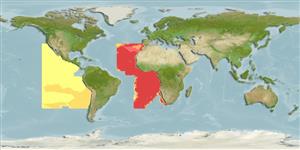分类 / Names
俗名 | 同种异名 | Catalog of Fishes(属, 种) | ITIS | CoL | WoRMS | Cloffa
Teleostei >
Lampriformes (Velifers, tube-eyes and ribbonfishes) >
Radiicephalidae (Tapertails)
Etymology: Radiicephalus: Latin, radius + Greek, kephale = head (Ref. 45335).
Environment: milieu / climate zone / depth range / distribution range
生态学
海洋; 深度上下限 570 - ? m (Ref. 58018). 深水域; 38°N - 40°S, 130°W - 20°E
Eastern Atlantic: off Morocco and the Azores (Ref. 6739) southward to Cape Point, South Africa (Ref. 6551). Eastern Pacific: present in the California Current region (Ref. 36609).
東大西洋: 外海的摩洛哥與亞速群島 (參考文獻 6739) 向南至南非的尖岬。 (參考文獻 6551) 東太平洋: 出現在加利福尼亞海流區域。 (參考文獻 36609)
大小 / 重量 / 年龄
Maturity: Lm ? range ? - ? cm
Max length : 76.0 cm TL 雄鱼/尚未辨别雌雄; (Ref. 4506)
背棘 (总数) : 0; 背的软条 (总数) : 152 - 160; 臀棘: 0; 臀鳍软条: 6 - 7; 脊椎骨: 114 - 121. Body and tail silvery in color; dorsal base blackish (Ref. 6551). Branchiostegal rays: 4-6 (Ref. 36609). Pelvic fins absent in adults.
身体与尾部银色的颜色; 背鳍基底黑色的.(参考文献 6551) 鳃条骨: 4-6.(参考文献 36609) 腹鳍不存在于成鱼。
Mesopelagic species (Ref. 6808). Adults feed on lantern-fishes (Myctophidae) and possibly euphausiid crustaceans (Ref. 6739). Oviparous, with planktonic larvae (Ref. 36609). They have the ability to discharge dark brown fluid from the ink-sac when alarmed.
海洋中层鱼种.(参考文献 6808) 成鱼吃灯笼-鱼 ( Myctophidae) 与可能地磷虾甲壳动物.(参考文献 6739) 卵生的, 仔鱼为浮游性.(参考文献 36609) 当危险警报,他们有能力排放深褐色的液体从墨水囊。
Life cycle and mating behavior
成熟度 | 繁殖 | 产卵场 | 卵 | 孕卵数 | 仔鱼
Oviparous (Ref. 36609).東大西洋: 外海的摩洛哥與亞速群島 (參考文獻 6739) 向南至南非的尖岬。 (參考文獻 6551) 東太平洋: 出現在加利福尼亞海流區域。 (參考文獻 36609)
Aguiar, A. and J.-C. Quéro, 1990. Trachipteridae. p. 647-649. In J.C. Quero, J.C. Hureau, C. Karrer, A. Post and L. Saldanha (eds.) Check-list of the fishes of the eastern tropical Atlantic (CLOFETA). JNICT, Lisbon; SEI, Paris; and UNESCO, Paris. Vol. 2. (Ref. 4506)
世界自然保护联盟红皮书 (Ref. 130435: Version 2024-1)
人类利用
工具
特别资料
下载 XML
网络资源
Estimates based on models
Preferred temperature (Ref.
123201): 4.5 - 7, mean 5.8 °C (based on 5 cells).
Phylogenetic diversity index (Ref.
82804): PD
50 = 1.5000 [Uniqueness, from 0.5 = low to 2.0 = high].
Bayesian length-weight: a=0.00389 (0.00180 - 0.00842), b=3.12 (2.94 - 3.30), in cm total length, based on all LWR estimates for this body shape (Ref.
93245).
营养阶层 (Ref.
69278): 3.9 ±0.63 se; based on food items.
Fishing Vulnerability (Ref.
59153): Moderate to high vulnerability (50 of 100).
